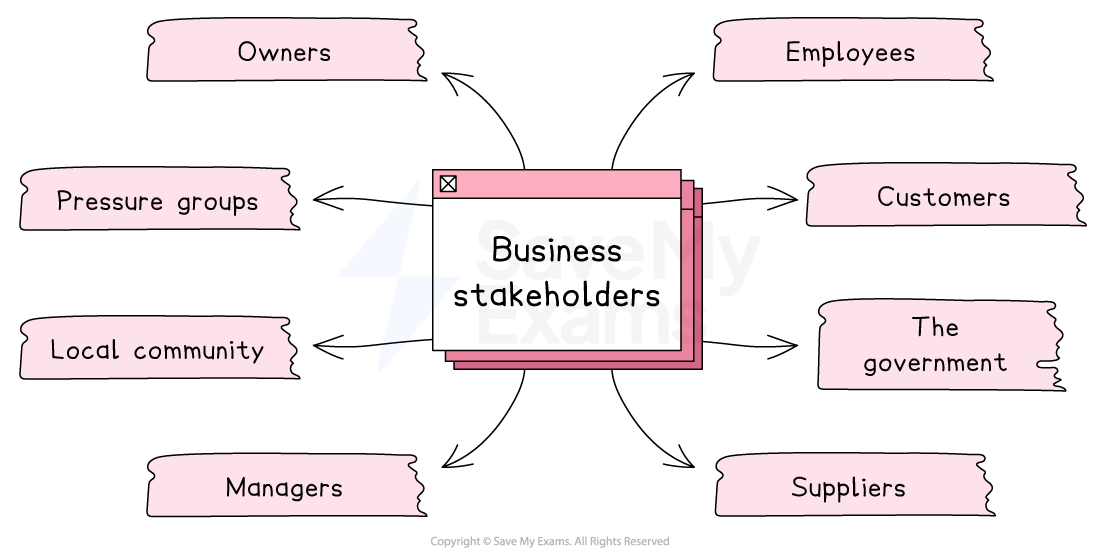Syllabus Edition
First teaching 2025
First exams 2027
The Role of Stakeholder Groups (Cambridge (CIE) IGCSE Business): Revision Note
Exam code: 0450, 0986 & 0264, 0774
Internal stakeholders
Business stakeholders are individuals or groups that affect or are affected by the actions of a business
External stakeholders are people and organisations that are outside of the business and include suppliers, governments, customers, lenders, such as banks, and the local community
Internal stakeholders include anyone within the organisation, such as employees, owners, shareholders, and managers

Typical internal stakeholder objectives
Owners (sole trader, partners and shareholders)
Owners of small sole trader businesses often want to be able to earn a living, achieve a certain lifestyle or gain recognition for their work
Partners often look to offer a range of services and may be focused on achieving organic growth
Shareholders are individuals or entities who own a portion of a company's stock
They invest in the company to make a profit
Their primary objective is to maximise their returns on their investment
E.g. A shareholder of Apple may want the company to release new products and increase sales to increase the value of their shares
Employees
Employees are individuals who work for a company
Their primary objective is to earn a living, have job security, be paid fairly for their work and have a safe working environment
E.g. Google employees in California have some of the best working conditions in the world, with sleeping pods, games rooms and free speciality coffee all-day
Managers
Managers are responsible for the day-to-day operations of a company
Their primary objective is to meet the company's goals and objectives
They want to maximise profits and minimise costs while ensuring that the company operates efficiently
E.g. A manager of McDonald's may want the restaurant to increase sales and reduce costs by improving efficiency
Objectives of external stakeholders
Suppliers
Suppliers are individuals or businesses that provide goods or services to a business
Their primary objective is to sell products or services and make a profit
Suppliers want to be paid on time and have a long-term relationship with the company
For example, Busco Sugar Milling supplies Coca-Cola with 84% of the sugar used in the manufacture of its soft drinks. It wants the company to continue buying their sugar and to pay bills on time
Customers
Customers are individuals or businesses who purchase goods/services from a business
Their primary objective is to receive high-quality products at a fair price
Customers also want good customer service, clear communication and a positive buying experience
The local community
The local community includes individuals and organisations that live or operate in the area where a business operates
Their primary objective is for the business to have a positive impact on the community
This may include the business being environmentally responsible, providing jobs, and contributing to local causes
For example, Burnley Savings & Loans Ltd donates all of their profits to local charities and good causes
Government
The government is responsible for creating and enforcing laws and regulations that affect businesses
Their primary objective is to promote the public good and protect the interests of citizens
The government wants companies to operate within the law and contribute to the economy
Lenders
Lenders are individuals or financial institutions (like banks) that provide loans or credit to a business
Their primary objective is to be repaid on time with interest, so they can make a return on the money they lend
Lenders also want the business to be financially stable and low-risk, so they feel confident their money is safe
For example, International bank HSBC expects regular repayments on loans and may want to see business accounts or cash flow forecasts to check a business can afford repayments before it grants a loan
Stakeholder conflict
Stakeholder groups can have conflicting interests and objectives, which can lead to tensions and conflicts
Shareholders may prioritise profit maximisation, while employees may prioritise fair treatment and high wages
Customers may prioritise low prices, while the local community may prioritise environmental sustainability which raises costs and prices
These conflicts can create challenges for businesses to balance the competing demands of different stakeholder groups
For example, a company may need to invest in costly environmental technology to meet the demands of the local community, but this may reduce profitability and upset shareholders
Conflicts can also arise when stakeholders have different levels of power and influence
For example, pressure groups with strong public support may be able to influence business activity more than individual shareholders
Managing stakeholder conflicts requires careful communication, transparency and compromise
Examples of stakeholder conflicts
Stakeholders | Conflict |
|---|---|
Employees vs employers |
|
Pressure groups vs government |
|
Local communities vs developers |
|
Examiner Tips and Tricks
Be ready to explain conflicts between stakeholder objectives – for example, shareholders may want higher profits while employees seek higher wages. Showing this tension demonstrates strong understanding

Unlock more, it's free!
Did this page help you?